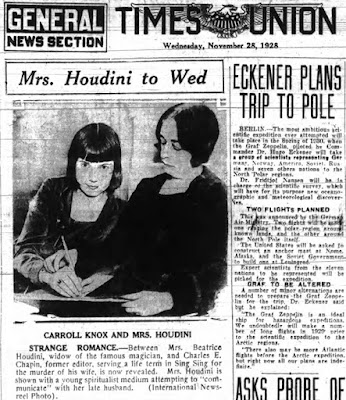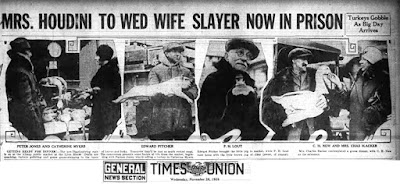An article, I Knew Houdini, appeared in The American Weekly on June 20, 1945. It was written by Joe Lee who claimed to have been “the long and personal representative of Houdini.” Many magicians at the time wondered if Lee was a pseudonym for someone else, or just someone trying to cash in on Houdini’s legacy. In fact, Lee was Houdini’s advance man for a time and was largely responsible for keeping Harry’s name in the public’s eye and bringing audiences into the theaters.
Joe “Doc” Lee is a name Houdini enthusiasts rarely stumble upon. He isn’t mentioned in the master magician’s popular biographies, yet he did play an important role in Houdini’s success later in life. Lee, a highly effective ad man, utilized the media and promotional stunts to keep his clients in the public eye and bring people into the theaters.
Before working with Houdini, Joe was associated with Tom Mix and his European tour of 1924-25. Mix was one of the biggest silent movies stars in Hollywood during the 1920s, appearing in more than 300 westerns and making as much as $10,000 a week. Mix (Hezikah Mix) actually was as a cowboy and served as a soldier during the Spanish-American War. Lee cranked up his publicity machine and under his direction, Tom and his horse, Tony, toured around the world to wildly enthusiastic and packed houses.
Lee’s extraordinary knack for getting publicity did not go unnoticed. L. Lawrence Weber, a theatrical impresario, offered Lee the position of advance man for Houdini in the Summer of 1925. The job of an advance man in the entertainment industry is to visit locations before the arrival of a performer to make the appropriate arrangements and create a buzz for their upcoming performances.
At this point in his career Houdini had begun to wage war with the spiritualists and Weber (and Lee) thought it was a good idea to exploit the spiritualists in the cities the tour would be visiting. Lee accepted Weber’s offer and it was reported that his contracted salary was “nearly a record.” Joe signed on for 40 weeks with the Houdini show and went straight to work.
Like Houdini, Lee was a showman. He believed that any successful promotional campaign keep in mind three criteria: the public wants to be thrilled, it wants to laugh, and women love to cry. If the promotion contained all three components it would be a hit.
The headline “Houdini’s Show Starts Touring Road Monday” appeared in Billboard, September 5, 1925. The story read, “Houdini and his company left New York for Pittsburgh this week, where his road show is to open Monday, September 7. The show, which is being presented by L. Lawrence Weber, carries a 60-foot car of scenery and apparatus. Houdini will be assisted by 20 people. The show is to play at a $2 top and will be divided into three parts, consisting of old-time magic, escapes and spiritualistic exposes. Joe Lee is traveling ahead of the show as general representative for Houdini. William Howe officiates as agent and A.L. Smith is back with the company.”
Variety (Sept. 30, 1925) reported that Houdini took in $6,000 the first week and $5,500 the second. The entire season was successful and lucrative for Houdini. Joe Lee played a major role in Houdini’s success during the ‘25 season. He visited local papers, befriended any newspapermen he could find, and gave them all the Houdini news they could ever want. The newspapers gladly committed several columns of publicity in their paper’s pages to Houdini and his exploits.
Lee continued to build up Houdini in a big way in 1926 and play a major role in his making the public aware of Harry’s fights against the spiritualists. He traveled to Washington D.C. ahead of Houdini and set the groundwork for the Congressional hearing on House Resolution 8989, which would ban the practice of “fortune telling” in the District of Columbia.
Chicago newspapers were particularly fond of Lee’s “planted” newspaper tie-ins with Houdini’s exposure of the city’s mediums. These compelling stories and exposés attracted readers to their papers and increased their circulation. In turn, Houdini garnered more newspaper real estate than he could imagine. Because of Lee’s publicity machine, Houdini’s Windy City engagements were often extended and audiences had to be turned away because of capacity crowds.
Despite all his success promoting Houdini, Joe Lee rejected an offer to continue with the Houdini show in the Fall of 1926. Variety wrote that “Houdini received more publicity under Lee’s guidance than he had previously got in his entire career.” Unfortunately, Lee never had the chance to work for Houdini again. The great magician and escape artist died on October 31, a few weeks after starting his 1926 season.
In 1929 Lee became the savior of many of R-K-O’s poorly performing theaters in Brooklyn, New York. Using his considerable skills as a promoter, Joe revived these theaters back to life and made them turn a profit. His ability to turn around such movie-house earned him the nickname, “Doc.” By the end of the 1930s, Joe was working as the advertising and publicity director for the Fabian Theatre chain in Brooklyn.
A decade later word got out that Paramount Studios had registered Houdini’s name and was going to make a motion picture about his life. The Film Daily (April 4, 1941) reported, “And it was Joe (Lee) who during his years with the magician…put “sex” in Houdini…but how is Joe’s secret.” Lee had amassed hundreds of clippings and scrapbooks on Houdini and many thought he would be the best source for exciting stories on the master magician.
Joe continued to praise Houdini and promote his legacy long after his passing. On the 10-year anniversary of Houdini’s death in 1936, Beatrice Houdini and Dr. Edward Saint conducted a séance in Hollywood to get in touch with the spirit of Houdini. In New York City, on the same day, Hardeen attempted another séance in with the medium Lillian Starr Weed. Joe Lee, Rose Mackenberg, Elmer Ransom, and John Mulholland were also in attendance at the event. Both of the events were broadcast on the radio, but Houdini never made an appearance.
In the 1950s Paramount Pictures renewed their interest in producing a motion-picture on the legendary escape artist & magician’s life. Lee never had a chance to see the film about his old friend, Houdini. Joseph F. Lee died on April 2, 1951. Newspapers around the country in ran a blurb once again suggesting Paramount contact Joe’s widow, Florence, who “has his (Houdini’s) trunkful of data, which could not be gathered from any other source.” The studio never did contact Mrs. Lee, but the motion picture, Houdini, starring Tony Curtis, was released in 1953.
An interesting footnote to Joe Lee’s story is after his article, I Knew Houdini, appeared in The American Weekly, a Detroit-area writer and editor, questioned Lee’s credibility. That man was Robert Lund, a rabid collector an aficionado of magic. Many will recognize Lund as the man who went on to create the American Museum of Magic in Marshall, Michigan.
A few years later after Lee’s story was published Lund wrote about the author in the December, 1952 issue of The Sphinx. “A week or two later my path crossed that of Walter Gibson. Because certain technical touches in the AMERICAN WEEKLY story hinted that it had been written by Gibson, I charged him with writing it under the pseudonym of Lee. “Not so!” he exclaimed. Lee, Gibson explained, was the press agent who piloted Houdini’s last show.”
Much to Lund’s surprise, Joe Lee was living in retirement in his own home town of Detroit on 1280 Lemay Street. Bob thought Lee, who by that time was arthritic and had a heart ailment, was one of the few living people who could recount Houdini’s last weeks on earth before his untimely death. Filled with excitement, Bob arranged an interview with Lee and set a tentative date for the first week of April, 1951. Unfortunately, fate intervened, and Joe Lee died before Lund could talk to him.
Obviously, much credit is due to Joe Lee for promoting Houdini – in life and death. Lee’s publicity efforts added a great deal to the printed history of the escape king. Like the American Weekly story headline said, he did know Houdini, and both men were better for it.
Copyright 2016 Chuck Romano























